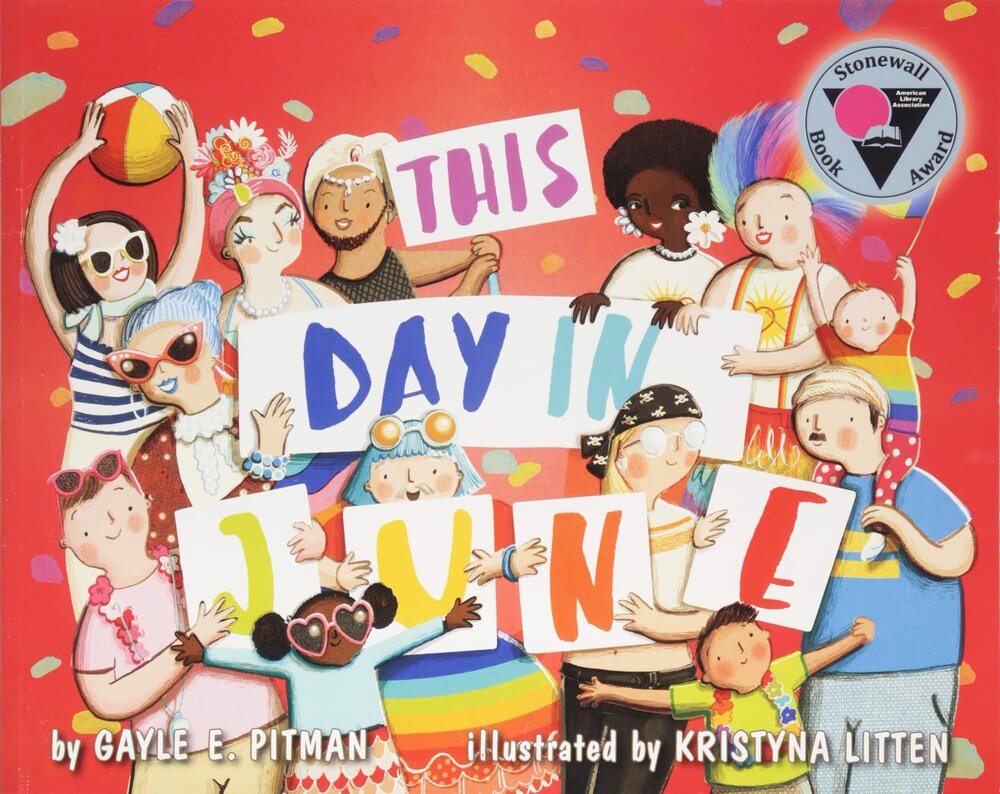
Inclusive Children's Book Teaching Guide
This Day In June
What is this book about?
This day in June . . .
Parade starts soon . . .
Rainbow arches . . .
Joyful marches!
In a wildly whimsical, validating and exuberant reflection of the LGBTQ+ community, This Day In June welcomes readers to experience a Pride celebration and share in a day when we are all united.
A note to parents and other caregivers at the end of the story explains the themes and groups represented on each page and includes facts about LGBTQ+ history and culture. This short teaching guide also offers tips on how to initiate and moderate age-appropriate discussions about LGBTQ+ people with children ages 3–18.
Who is depicted in this book?
- LGBTQ+ people, couples and families
- Children or adults who transcend gender stereotypes
- Racially/ethnically diverse people celebrating Pride together
What early childhood themes and concepts does this book explore?
- Different types of relationships and families
- People dress in many different ways and in different types of clothing.
- Parades as one way that people gather together
- Pride as a celebration: Each page of the book features groups of children, adults and families celebrating Pride and marching in a Pride parade.
How does this book support anti-bias education?
This Day in June portrays a town and its residents as the day of the annual Pride parade dawns and everyone celebrates. Along with other books, this story can be used to represent and affirm diverse people, families and relationships to all children and to highlight what all families share.
This Day in June also includes images that can spark further discussion about flags, parades, the diversity within the LGBTQ+ community, and the messages featured on the signs carried by the Pride parade marchers.
Depending on how the book is shared or used—and the developmental level of the children—This Day in June may be used to support the following core goals from Anti-Bias Education for Young Children and Ourselves:
Identity—Teachers will nurture each child’s construction of knowledgeable and confident personal and social identities so that children will demonstrate self-awareness, confidence, family pride, and positive social identities.
Diversity—Teachers will promote each child’s comfortable, empathetic interactions with people from diverse backgrounds so that children will express comfort and joy with human diversity, use accurate language for human differences, and form deep, caring connections across all dimensions of human diversity.
How can this book be used to meet early childhood learning standards?
For all ages
Use This Day In June to meet early childhood literacy standards
For children from birth to age three
Teaching suggestion: Point out familiar objects and settings in the book, some of which are organized by related colors.
What Illinois Early Learning Guideline does this meet for children from birth to age three?
Developmental DomainCognitive Development
Standard: Concept DevelopmentChildren demonstrate the ability to connect pieces of information in understanding objects, ideas and relationships.
Indicators for children:
- Begins to identify and name objects and people (16–24 months)
- Begins to identify characteristics of the object, such as “red ball” (16–24 months)
- Identifies characteristics of objects and people when named, such as colors (21–36 months)
Teaching suggestion: Point out the ways that the people in the book are celebrating, showing their happiness and pride, and showing love and affection for one another.
What Illinois Early Learning Guideline does this meet for children from birth to age three?
Developmental DomainSocial-Emotional Development
Standard: EmpathyChildren demonstrate an emerging ability to understand someone else’s feelings and to share in the emotional experiences of others.
Indicators for children:
- Shares in and communicates simple emotions of others (16–24 months)
- Communicates how other people may be feeling and why (21–36 months)
For preschoolers (ages three to five)
Teaching suggestion: Encourage the children to notice and discuss similarities and differences among family structures and members.
What Illinois Early Learning and Development Standards does this meet for preschoolers?
Social Studies Standard18BDevelop an awareness of self within the context of family.
Benchmark 18.B.ECa:
Understand that each of us belongs to a family and recognize that families vary.
Teaching suggestion: Encourage the children to notice and discuss human diversity, including skin color. Probe their assumptions about gender expression and expand their ideas about how gender “looks.”
What Illinois Early Learning and Development Standards does this meet for preschoolers?
Social Studies Standard18AExplore people, their similarities and their differences.
Benchmark 18.A.ECa:
Recognize similarities and differences in people.
Teaching suggestion: Compare this book with another book about a Pride parade, such as Pride Puppy by Robin Stevenson. Discuss what the children notice about these two different depictions of Pride celebrations. Ask the children to talk about large celebrations and parades that they have attended.
What Illinois Early Learning and Development Standards does this meet for preschoolers?
Language Arts Standard2DEstablish personal connections with books.
Benchmark 2.D.ECb:
With teacher assistance, compare and contrast two stories relating to the same topic.
Teaching suggestion: As you read the book aloud, stop and ask the children what they see in the illustrations to generate discussions about new words and concepts. Introduce more challenging concepts such as "united," "vote" or "equality."
What Illinois Early Learning and Development Standards does this meet for preschoolers?
Language Arts Standard1EUse increasingly complex phrases, sentences and vocabulary.
Benchmark 1.E.ECb:
Exhibit curiosity and interest in learning new words heard in conversations and books.
Benchmark 1.E.ECc:
With teacher assistance, use new words acquired through conversations and book‐sharing experiences.
What Illinois Early Learning and Development Standards does this meet for preschoolers?
Social Studies Standard14CUnderstand ways groups make choices and decisions.
Benchmark 14.C.ECa:
Participate in voting as a way of making choices.
Teaching suggestion: Ask the children what they think the word Pride means. Discuss why people need to feel a sense of pride and emphasize that Pride celebrations bring people together in a safe and caring community.
What Illinois Early Learning and Development Standards does this meet for preschoolers?
Social/Emotional Development Standard31ADevelop positive relationships with peers and adults.
Benchmark 31.A.ECb:
Recognize the feelings and perspectives of others.
See inside this book.

What other resources are available?
Visit the American Psychological Association website for a sample of this book.
Learn more about Pride flags and how to use them as teaching tools here.
